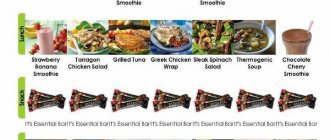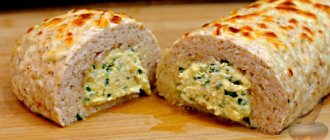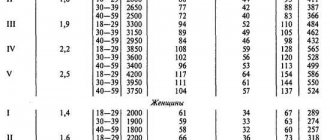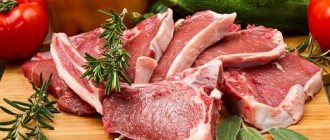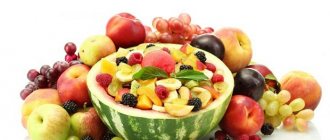What is the right way to start the day, proteins or carbohydrates? There are several opinions on this matter. Since childhood, we have been taught that we need to eat porridge in the morning, because it gives us energy for the whole day. However, today an alternative opinion has emerged, according to which it is better to consume protein foods for breakfast. This theory appealed to bodybuilders, for whom protein is the best product for muscle growth. And some even believe that there is no need for breakfast, since they feel great without it.
What are simple and complex carbohydrates
Carbohydrates are the building blocks of our energy. Complex organic compounds are necessary for the full functioning of the body of people, animals and plants. Sugars are included in a large number of compounds involved in regulating the functioning of the human body. Carbohydrates perform several main functions:
- Energy – provide nutrition to cells and support their vital functions.
- Structural - act as builders of the cell membrane and are part of DNA.
- Preservative – provide a reserve by making reserves in the body.
- Protective – support the immune system and protect cells.
Once in the digestive system, carbohydrates are broken down to release energy. When 1 g of carbohydrates breaks down, 0.4 g of water and 4.1 kcal are released. For normal functioning, the human body must consume 2 g of carbohydrates per 1 kg of weight. There are several types of sugars depending on the number of structural units:
- Monosaccharides – 1 unit. These are glucose, fructose, ribose and deoxyribose.
- Oligosaccharides – from 2 to 4 units. Sucrose, lactose, maltose.
- Polysaccharides – from 4 units. Starch, glycogen, cellulose and chitin.
The first two types of carbohydrates have a high glycemic index. Once in the digestive system, they are absorbed very quickly and converted into glucose. When there is a large influx of these sugars, the body turns on a defense mechanism to avoid hyperglycemia. This is a dangerous condition in which the sugar level increases greatly and the pancreas cannot cope. To avoid being bombarded with sugar, the body sends a signal to transform such sugars into fat.
When your glucose level rises sharply, you want to eat more. This is a vicious circle of simple carbohydrates.
Another thing is complex sugars. The largest amount of carbohydrates in the body are polysaccharides. Starch, glycogen and cellulose consist of chains of units that take a long time to break down and therefore saturate the blood with glucose slowly and evenly. In addition, more energy of the body itself is spent on this. Provides satiety for 3-5 hours.
Buckwheat porridge with mushrooms
A flavorful breakfast suitable for vegans, vegetarians and buckwheat lovers.
BJU per serving: proteins - 13 g, fats - 15 g, carbohydrates - 53 g. Buckwheat is responsible for carbohydrates, buckwheat and mushrooms are responsible for proteins, butter is responsible for fats.
Ingredients per serving:
- 70 g of dry buckwheat is about five tablespoons;
- 10 g sunflower oil - one tablespoon;
- 100 g of champignons - three to four large mushrooms.
Preparation: Pour cold water over buckwheat and cook for 15 minutes over medium heat. Wash the mushrooms, cut into slices and fry in a tablespoon of vegetable oil. Mix the prepared buckwheat with mushrooms, salt and pepper to taste.
The main principle of the carbohydrate diet
It lies in understanding the glycemic index of carbohydrates and burning them correctly. The glycemic index is the rate at which sugars are processed in the body. Simple carbohydrates have a high index, complex carbohydrates have a low index. The lower the index, the more beneficial the product is for the body.
The essence of the carbohydrate diet is to get rid of accumulated fat and prevent an increase in fat reserves. To avoid reducing glucose levels to dangerous lows, simple sugars are not completely eliminated. This method is often used by athletes and women to “dry out,” that is, to reduce subcutaneous fat reserves. Nutritionists have developed several basic principles for effective weight loss:
- per day you need to drink at least 1.5 liters of clean water per day;
- a portion of food should not exceed 200 g, liquid - 150 ml;
- It’s better if the meals are fractional (5-6 times a day);
- do not eat 3-4 hours before bedtime (eating before bedtime impairs sleep and can lead to swelling);
- fatty, sweet, alcohol is excluded;
- physical activity must be present.
Thanks to the variety of foods, a carbohydrate diet is easier to tolerate than mono-diets.
The course of a carbohydrate diet for weight loss lasts two weeks. The first couple of weeks will be difficult - it means strict restrictions on portion size and number of calories. During this period you can lose 6-7 kg. With obesity, the loss will increase. Men will have a harder time losing weight on a carbohydrate diet than women.
In the second week of the course, the results are consolidated. According to reviews, a little weight may return in the last week - about 10% of what was lost, but this is not scary. If you continue to eat right and add exercise, your weight will stabilize.
There is a diet option designed for 1 week, but it is more stringent. You need to prepare yourself for it mentally and physically.
Proper breakfast
After waking up, you need to drink a glass of warm water with a slice of lemon. And only after 20-30 minutes you can start eating.
The three most important components of a healthy breakfast are fiber (or carbohydrates), healthy fats and protein.
- Protein - plant or animal. Egg, boiled chicken, fish, cheese, cottage cheese, nuts, legumes.
- Healthy fats can include: unrefined cold-pressed oils (olive, avocado, pumpkin oil), ghee, peanut butter, almond urbech.
- For carbohydrates and fiber you should have: vegetables, greens. Long-cooked whole grain cereals. Whole grain or rye bread without yeast.
- Berries and fruits for dessert.
If after breakfast you do not plan physical activity or sports, and your work consists of prolonged sitting in the office, then reduce carbohydrates to a minimum.
Balanced breakfasts for weight loss should be as light and small in volume as possible.
I will add that the maximum calorie content for breakfast is 400 calories to maintain weight. And if you want to lose weight, then your breakfast should not exceed 300 calories.
Protein-carbohydrate alternation (PCA) and its basics
The protein-carbohydrate diet is one of the most popular systems for those losing weight. It has proven itself well and is in particular demand among athletes and professional bodybuilders. The diet allows you to get rid of fat and maintain muscle relief, eliminating their atrophy. A lot of proteins and complex carbohydrates in the diet help increase endurance and get more results from training. Now this diet is relevant not only among athletes: those who want to lose weight and maintain muscle mass actively use it.
Basic principles:
- No hunger strikes. A nutritious, stress-free diet.
- Weight loss occurs by burning fat, not by breaking down muscle mass.
- The menu is simple and inexpensive.
- Improves metabolism.
- Improves results from physical activity.
The diet is based on the principle of alternating proteins and carbohydrates every day. On a protein day, the body does not receive carbohydrates, so energy is drawn from already stored fat. At the same time, the muscles are not subject to destructive changes. With this type of nutrition, endurance and physical strength increase.
On carb day, lost energy is replenished. But remember, no amount of alternation will help if the majority of your diet consists of fast carbohydrates. It is best to maintain a 1:3 ratio, where three parts are complex sugars and the rest are simple sugars. The main secret to the success of the diet is the correct, strict alternation of foods. Then you won’t have to give up your favorite foods and go hungry.
The diet lasts from a week to four. If you want to continue losing weight, you need to take a break after finishing the diet. This will help restore psychological stability and reduce the “plateau” effect when the weight stops coming off.
During the diet, physical activity is required, even if it’s just morning exercises. If this is not done, the abundance of protein will affect the shape of the waist and abdomen. A few more important rules for a successful diet:
- Skip the spices. Refers mainly to those that are capable of retaining water in the body (salt, soy sauce) and increasing appetite (black pepper, coriander, cinnamon).
- Don't eat sugar. This also applies to juices from packages; it is better to choose freshly squeezed juice. Ideally, eat the fruit, because its shell contains the largest amount of vitamins and minerals.
- Limit frying and use of oil. Bake, stew and steam – it’s tasty and healthy. During the diet, it is better to forget about smoked dishes.
- Drink enough water. There is an opinion that you need to drink 1.5 liters of clean water per day. In fact, you need to be able to listen to your body and drink as much as it asks.
Standard power supply circuit for BUCH:
- the first two days are protein days;
- the third day is carbohydrate;
- the fourth is mixed.
Then the course is repeated until a certain period. You can also leave only two protein and two carbohydrate days, alternating them.
When alternating days, the amount of substance is calculated based on body weight:
- Protein. On protein consumption days, eat 3-4 g per 1 kg of weight that is planned to be gained in the end. Fats and fiber should make up no more than 10% of the total volume of products.
- Carbohydrates – 6 g per 1 kg of desired weight. You can also have protein these days, but not more than 1 g/kg.
- On a mixed day, consume 3 g of protein and carbohydrates per kilo of weight.
No extra calories
Making sandwiches
The creation of the sandwich, like any other self-respecting dish, was not without a legend.
It is generally accepted that the English version of sandwiches, where the filling is between two pieces of bread, was invented by John Montagu, a diplomat and gambler. He spent a lot of time playing cards, ate right after them and, in order not to get his hands dirty, covered the fatty ham with a second piece of bread. Montagu bore the title Earl of Sandwich, and the dish was named after him.
In fact, everything was a little different. The Earl of Sandwich really existed, but he was not a gambler. He lived in rather cramped circumstances, was always in need of money and worked very hard: he was a Lord of the Admiralty (Minister of the Navy) and later Foreign Secretary. Workaholism and eternal economy led to the fact that John Montague ate mainly sandwiches. Whether he covered them with a second piece of bread or not is unknown.
Nowadays, the sandwich is no less popular a snack than in Montague's time. It's fast, nutritious, simple, economical. True, many are sure that it is not suitable for those who watch their figure. But these are all prejudices. The sandwich may well be healthy and low-calorie.
Pancakes, soups and sandwiches. What to cook from yesterday's sausage Read more
Principles of a proper sandwich
- If the bread is whole grain. And even better, dried in a toaster or in a frying pan without oil, or slightly stale.
- It is better not to take bread with nuts and seeds; although it is tastier, it is higher in calories. But with bran it’s just the same.
- We steam meat and poultry or take it baked without oil and mayonnaise.
- Sauces: yogurt, kefir, mustard, adjika.
- Lots of greens and vegetables - they will fill the stomach, so it will be easier to eat such a sandwich, and the vegetable filling contains very few calories.
- Add spicy greens to the sandwich, they create a rich taste and contain many vitamins and nutrients, thanks to which the body receives the necessary elements
Recipes
Sandwich with tuna or salmon
8 slices of rye bread, 1 can of canned tuna (you can take canned salmon), 1 cucumber, 2 tbsp. spoons of yogurt, ½ teaspoon of wasabi paste, 2 handfuls of arugula, salt and pepper.
Remove the fish from the jar and mash with a fork, adding a little juice. Peel the cucumber and finely chop it or grate it on a coarse grater. Mix cucumber and fish, add some yogurt and wasabi to create a creamy filling.
Dry the bread in the oven or in a dry frying pan, spread the filling on 4 pieces, place arugula on top, cover with the remaining pieces. You can add cucumbers and tomatoes.
Bean sandwich
4 whole grain rolls or 8 slices of bread, 1 can of canned white or red beans, ½ bunch of fresh cilantro, 100 g feta cheese, salt, pepper, olive oil.
Remove the beans from the jar and drain the water, chop the cilantro, mix with the beans and puree in a blender, adding the juice from the beans to obtain a delicate creamy consistency.
Cut the buns and dry them in a dry frying pan or in the oven at low temperature. You can sprinkle with olive oil. Finely chop the cheese. Generously spread one half of each bun with bean paste. Sprinkle with cheese. You can add greens or lettuce leaves. Cover the filling with the other half of the bun and heat the sandwiches in the oven for 2 minutes.
Loved and hated. 5 delicious recipes for homemade burgers Read more
Table of foods for women on a carbohydrate diet
| Protein day | Carbohydrate day |
| Lean poultry (chicken, turkey) | Cereal porridges (oatmeal, buckwheat, rice, millet, etc.) |
| Lean beef or veal | Starchy vegetables (potatoes, corn, pumpkin, legumes, cauliflower) |
| Seafood (shrimp, octopus, scallops, squid) and fish (low-fat varieties: pollock, cod, haddock) | Bread and crispbread (whole grain, it is better to exclude white bread due to fast carbohydrates) |
| Eggs | Durum wheat pasta |
| Dairy products (low-fat milk, kefir, yogurt, curdled milk) | Fruits (any) |
| Nuts (almonds, walnuts, hazelnuts, pine nuts, cashews) | |
| Non-starchy vegetables (broccoli, zucchini, carrots, beets, cabbage) |
What can diabetics eat on a carbohydrate diet?
Patients with diabetes must provide the body with enough carbohydrates to regulate blood sugar levels. With diabetes, you need to monitor three indicators: glycemic index, insulin index and calorie content. Of the permitted products:
- baking with buckwheat, rye, rice flour;
- beef, turkey, rabbit, salmon, pollock;
- mangoes, apricots, cherries, bananas, green vegetables;
- cereals (except white rice and semolina);
- Dairy products should be low in fat; you shouldn’t lean too much on them.
The importance of morning meals
As already mentioned, it is the first meal that launches the main processes of the body. In addition, breakfast helps to restore strength after sleep - after all, even at night, a certain amount of energy is expended, which goes to maintaining vital functions. Breathing, blood circulation, muscle contraction, brain functioning, organ function and more - all these are processes for which the body needs fuel.
Why else is breakfast so important? The following reasons are given:
- The first step on the path to slimness. Statistics show that the metabolism of people who eat breakfast is 2-5% higher than that of those who regularly skip their first meal. This means that people who prefer a cup of coffee to a full meal can gain up to 2-4 extra pounds per year.
- The first step towards a healthy heart. A healthy, proper breakfast helps reduce the level of “bad” cholesterol and improve the functioning of the cardiovascular system. The result is a reduced risk of blood clots, heart attack and stroke.
- Improved brain function. A nutritious breakfast helps increase concentration, improve memory, and improve reaction. All this is especially important for schoolchildren, students and people whose work is directly related to mental activity.
- Protection from stress. If a person skips one of the meals, the body experiences stress, all its systems go into defense mode. Therefore, the reaction to external stimuli intensifies: any life situation can cause discomfort and apathy.
- Strengthening immunity. A breakfast rich in prebiotics, probiotics and fiber helps improve intestinal microflora, which in turn enhances the body's natural defense reactions. It is better resistant to viruses, infections, and various pathogenic bacteria.
- Improved mood. A delicious breakfast in the morning, a cup of aromatic coffee or tea - all this will not only start the body’s processes, but also provide a boost of vivacity, energy, help you collect your thoughts, and set yourself up for the day.
- The key to beautiful skin. A healthy, complete first meal supplies the body with the necessary nutrients, vitamins, amino acids, which has a positive effect on the appearance: the skin becomes healthy, radiant, and its elasticity increases.
The main thing is that breakfast is balanced, nutritious, healthy, and at the same time light. But how many calories, proteins, fats, carbohydrates should be allocated for breakfast? What are the rules and principles of this morning ritual? Let's take a closer look.
Carbohydrate diet for pregnant women
Pregnant women, when following any diet, need to be extremely careful and attentive to their body. Carbohydrates are the main sources of energy for women and children. In the first months of pregnancy, the need for insulin is greater than usual.
It is necessary to maintain optimal blood glucose levels and give preference to complex carbohydrates to avoid gestational diabetes.
Who needs breakfast?
There is a category of people who cannot do without this meal. They even need dietary breakfasts, as their body needs support.
- Pregnant women.
- To old people.
- People recovering from a long illness.
- People with stomach diseases.
- Athletes.
- For children.
Carbohydrate diet for gaining muscle mass for a girl
When gaining muscle mass on such a diet, there are rules for carbohydrate consumption. These substances provide calories that are used for muscle growth, which means you need to increase your calorie intake with complex sugars.
To gain 0.5 kg of muscle you need to add 250 kcal every week. Liquid carbohydrate supplements from the sports nutrition range and fruit smoothies help.
Sample menu
There are several types of carbohydrate diets.
Classic version
The classic type carbohydrate diet is designed for 2 weeks. At first, weight loss occurs, and then the result is consolidated. As a result, you can lose 6-8 kg. Below is an example of a menu for each day:
| Day of the week | Menu |
| Monday |
|
| Tuesday |
|
| Wednesday |
|
| Thursday |
|
| Friday |
|
| Saturday |
|
| Sunday |
|
Easy option
A light carbohydrate diet is used if the weight loss period will be long. During each week you can lose 1 - 2 kg, but the lost kilograms will not return.
With a light type of carbohydrate diet, you only need to give up white flour and sugar. The rest of the products can be eaten.
Strict version
A strict carbohydrate diet involves severe restrictions. It lasts a week, after which the normal diet gradually returns. It is advisable to limit sweets, fatty and floury foods even after leaving the diet. In a week you can lose up to 8 kg.
Menu for the week:
| Day of the week | What is allowed to eat per day? |
| Monday | 410 g oven-baked potatoes, some greens and 0.5 liters of kefir |
| Tuesday | 410 g cottage cheese and 0.5 l kefir |
| Wednesday | 410 g of any fruit and 0.5 l of fermented milk drink |
| Thursday | 410 g boiled chicken breast and 0.5 l fermented milk drink |
| Friday | Repeat Wednesday's diet, but choose other fruits or berries |
| Saturday | Fasting day. Only non-carbonated mineral water is allowed - 1.5 - 3 liters. Food is prohibited |
| Sunday | 410 g of any vegetables and 0.5 l of fermented milk drink |
Such a strict diet is allowed no more than once a month.
To build muscle mass
Men and women who are trying to get rid of body fat and at the same time build muscle mass through exercise can also benefit from a carbohydrate diet.
Before lunch, you should eat more food rich in carbohydrates, and in the afternoon - proteins. The course lasts approximately a month.
A sample menu for the day is as follows:
- Breakfast – buckwheat with mushrooms and 2 boiled eggs.
- Snack – cereal bar.
- Lunch – chicken breast baked with vegetables.
- Snack – banana and protein shake.
- Dinner – baked fish, salad with seafood and vegetables.
- Snack – cottage cheese with berries or a protein shake (casein).
Ectomorphs are recommended to consume as many carbohydrates as possible, both fast and slow types. You can also quickly gain muscle mass by drinking a high-carbohydrate gainer.
During pregnancy
If a representative of the fair sex is pregnant, then the diet should be balanced and varied so that the woman feels good and the fetus develops correctly. The specific gravity of proteins, fats and carbohydrates should be 25, 15 and 60%, respectively.
A sample daily menu for a pregnant woman is as follows:
- Breakfast - porridge of your choice (cook in water with milk - take both components in equal parts), 1 boiled egg, cheese, whole grain bread.
- Snack – cottage cheese with fruit.
- Lunch – borscht with sour cream, beef stew with vegetables.
- Snack – fruits or berries.
- Dinner – fish cooked in a steamer, salad with seafood.
- Snack: yogurt or kefir.
You should definitely consult your doctor first.
Quitting the Carbohydrate Diet
To exit a carbohydrate diet without regaining weight, you need to follow a number of rules:
- Base further nutrition on the basis of a diet with the gradual inclusion of other products.
- Do not overload the gastrointestinal tract with large amounts of food. During a diet, the volume of the stomach will decrease and a sharp increase in it can harm the body.
- Increase the grams of dishes gradually, not forgetting about healthy snacks.
What foods should you absolutely not have for breakfast?
In the morning, the pancreas and stomach are especially sensitive to sweets. By consuming any sweets for breakfast, you jeopardize the health of your entire body.
Eating seemingly harmless buns, cookies, sweets, cakes and pastries. As well as sugar (including cane sugar), date and maple syrups. Juices from the store, sweet curd cheeses, ice cream.
You are gradually developing big problems with your body.
Also, you should not eat various store-bought muesli, corn flakes, breakfast cereals, and instant cereals.
Chips, crackers, mayonnaise, ketchup.
Sausages, ready-made cutlets, nuggets, factory dumplings, even the best ones should not be consumed in the morning.
The only natural sweetener that you can eat for breakfast and not be afraid of harming your health is honey.
With one condition, that you know for sure that this product is natural and environmentally friendly.

